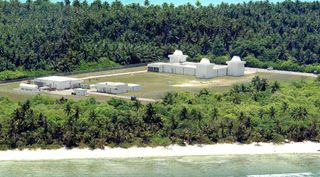Air Force Wants Help to Operate and Maintain Space Surveillance Telescopes

WASHINGTON — The Air Force Space Command last week posted a "sources sought" notice for the operations and maintenance of a network of space-staring telescopes known as the Ground-based Electro-Optical Deep Space Surveillance System.
The Air Force is sizing up the market and not seeking bids yet. Responses are due April 23.
The notice came from the 21st Contracting Squadron at Peterson Air Force Base, Colorado. The squadron is looking for help providing 16-hour-a-day, seven-day a week operations of GEODSS sites at Socorro, New Mexico; Diego Garcia, British Indian Ocean Territory; and Maui, Hawaii. A fourth GEODSS site in South Korea was closed in 1993. [The Most Dangerous Space Weapons Concepts Ever]
According to the Air Force, the three sites provide nearly complete coverage of the Earth's geosynchronous orbital belt and deliver nearly 80 percent of all geosynchronous observations. The data is sent to the Joint Space Operations Center at Vandenberg Air Force Base, California, and to U.S. Strategic Command's Joint Intelligence Center at Offutt Air Force Base, Nebraska.
This is the military's primary deep-space tracking system. The first site at Socorro, at the White Sands Missile Range, started operation in 1982. The GEODSS uses nine large telescopes at the three locations to track objects by using reflected sunlight, so it can only operate on clear nights. It can likely detect objects as small as a half-meter in geosynchronous orbits.
The telescopes were upgraded in the mid-2000s under a program called Deep Stare. Analog sensors were replaced with digital focal plane arrays. The Air Force Space Command noted that the upgrade gave the GEODDS sites "some of the most accurate and sensitive optical telescopes in the world." A fact sheet says the system can track objects as small as a basketball more than 20,000 miles away and is a "vital part of the AFSPC's space surveillance network."
Harris Corporation currently does contractor support work at all three GOEDSS sites. A one-year $8.5 million contract modification was awarded to the company May 2017 and runs through April 14.
Get the Space.com Newsletter
Breaking space news, the latest updates on rocket launches, skywatching events and more!
An industry consultant who is familiar with the GEODSS said the maintenance and operation of these sites is labor intensive and "cumbersome logistically," with facilities located in remote areas. "In my opinion, the Air Force ought to put all the GEODSS sites into a museum and just outsource the collection of ground based space situational awareness data to companies that are already doing this job well," he said. "There is no reason why the collection of SSA data has to be done by the military."
SSA efforts are drawing increased attention as space is now considered a battlefront. Having up-to-the-minute information on space objects would allow satellite operators fly spacecraft away from potential threats. The SSA task is becoming more complex with the proliferation of space junk orbiting the Earth.
The Air Force and the Defense Advanced Research Projects Agency developed a more advanced Space Surveillance Telescope to supplement the older systems. The SST is located at the White Sands Missile Range and operated by the Air Force Space Command and the Royal Australian Air Force to track space debris.
DARPA said the SST has moved space situational awareness from seeing only a few large objects at a time through the equivalent of a drinking straw, to a "windshield" view with 10,000 objects at a time, each as small as a softball. SST can search an area larger than the continental United States in seconds and survey the entire geosynchronous belt within its field of view — one quarter of the sky — multiple times in one night.
This story was provided by SpaceNews, dedicated to covering all aspects of the space industry.
Join our Space Forums to keep talking space on the latest missions, night sky and more! And if you have a news tip, correction or comment, let us know at: community@space.com.

Sandra Erwin covers the military and national security beat as a Senior Staff Writer at SpaceNews. Sandra, based in Arlington, Virginia, specializes in Defense Department and Intelligence Community space programs, policy, budgets, technology and the industry that supports this sector. She joined SpaceNews in October 2017. Before coming to SpaceNews, Erwin covered the U.S. military, the Pentagon, Congress and the defense industry for over two decades as editor of the National Defense Industrial Association's National Defense Magazine and Pentagon correspondent for Real Clear Defense.

